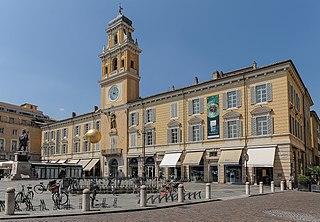
Parma is a city in the northern Italian region of Emilia-Romagna known for its architecture, music, art, prosciutto (ham), cheese and surrounding countryside. With a population of 198,292 inhabitants, Parma is the second most populous city in Emilia-Romagna after Bologna, the region's capital. The city is home to the University of Parma, one of the oldest universities in the world. Parma is divided into two parts by the stream of the same name. The district on the west side of the river is Oltretorrente. Parma's Etruscan name was adapted by Romans to describe the round shield called Parma.

Antonio Allegri da Correggio, usually known as just Correggio was an Italian Renaissance painter who was the foremost painter of the Parma school of the High Renaissance, who was responsible for some of the most vigorous and sensuous works of the sixteenth century. In his use of dynamic composition, illusionistic perspective and dramatic foreshortening, Correggio prefigured the Baroque art of the seventeenth century and the Rococo art of the eighteenth century. He is considered a master of chiaroscuro.

Tommaso Michele Francesco Saverio Traetta was an Italian composer of the Neapolitan School. Along with other composers mainly in the Holy Roman Empire and France, he was responsible for certain operatic reforms including reducing the ornateness of style and the primacy of star singers.

Girolamo Francesco Maria Mazzola, also known as Francesco Mazzola or, more commonly, as Parmigianino, was an Italian Mannerist painter and printmaker active in Florence, Rome, Bologna, and his native city of Parma. His work is characterized by a "refined sensuality" and often elongation of forms and includes Vision of Saint Jerome (1527) and the iconic if somewhat anomalous Madonna with the Long Neck (1534), and he remains the best known artist of the first generation whose whole careers fall into the Mannerist period.

Philip was Duke of Parma from 18 October 1748 until his death in 1765. A Spanish infante by birth, he was born in Madrid as the second son of King Philip V and Queen Elisabeth. He became Duke of Parma as a result of the 1748 Treaty of Aix-la-Chapelle. The duchy had earlier been ruled by Philip's elder brother, the future Charles III of Spain, and by their maternal ancestors. Philip founded the House of Bourbon-Parma, a cadet line of the House of Bourbon. He was a first cousin and son-in-law of the French king Louis XV.

Bartolomeo Schedoni was an Italian early Baroque painter from Modena.

Events in the year 1814 in Art.

The Galli–Bibiena family, or Galli da Bibiena, was a family of Italian artists of the 17th and 18th centuries, including:

Michele Desubleo (1601–1676), also called Michele Fiammingo (Flemish) or Michele di Giovanni de Sobleau, was a Flemish painter active in Central and North Italy during the Baroque era.

Lattanzio Gambara was an Italian painter, active in Renaissance and Mannerist styles. It is likely that Gambara is the same 16th century painter referred to as Lattanzio Cremonese or Lattanzio da Cremona.

Angelo Michele Colonna was an Italian painter of the Baroque period, active in Bologna, northern and central Italy and Spain. He is sometimes referred to as Michelangelo Colonna.
Events from the year 1697 in art.
Events from the year 1671 in art.

Giovanni Maria delle Piane was an aristocratic Genovese who served as primary court painter for over 60 years in the late-Baroque period. He is also known as "il Molinaretto".

Paolo Toschi was an Italian draughtsman and engraver. He was born in Parma.

Girolamo Alibrandi (1470-1524), was an Italian painter, born and active in Sicily, called the Raphael of Messina.

Santa Lucia is a Baroque-style Roman Catholic church located on Strada Cavour in central Parma, region of Emilia Romagna, Italy.

Filippo Mazzola was an Italian painter of the Renaissance period.

Laurent Pécheux was a French-born painter, active in Rome and Northern Italy in a Neoclassical-style.

Michele Guerra is an Italian academic and politician, Mayor of Parma since 2022.


















